If you’re not asking yourself this question – How can I do massage without being in pain?– then you’re probably in pain (and/or have a massage injury).
Pain from doing massage is a big. hairy deal.
Pain = loss of income.
Pain = potential massage injury.
Pain = an uncertain work future.
My Massage Injury Story
In June of 2013 I was in pain from my neck to my fingers.
The orthopedist said that I had an unstable shoulder joint, cervical radiculopathy and cubital tunnel syndrome.
He also told me to quit massage. And part of me agreed with him. A future of working with increasing pain was not sustainable.
But then part of me was like: Hey, buddy, you’ve gotten through a low back massage injury and plenty of pain issues before without having to hang up your hands. Figure it out.
As you may have guessed, I went with plan B–figure it out.
Working Plan B to Heal My Massage Injury
At first I wasn’t optimistic because the pain didn’t budge. But as time went on, I saw small improvements. The small improvements added up and I started to see that I was making progress towards making my massage injury and pain syndromes non-issues.
What was the catalyst for improvement?
You guessed it. Before and during each massage I’d ask myself “How do I get the job done without causing or increasing the pain?”.
Sounds a little obsessive, I know. But until you know what causes or exacerbates pain during a massage, you can’t fix it.
And by asking the question you’re setting yourself up to experiment with new strategies and techniques. By the way, when you experiment some of your old massage rules will be broken. That’s a good thing! Because they were causing you pain. (If you’re nervous about breaking massage rules read this.)
Here are two rules that I permanently broke: I always have to release the traps by squeezing AND I always have to do my signature effleurage stroke down the entire back.
(Warning: Your brain is going to rebel at the thought of changing some of the things that make your massage you BUT the return is “no pain”. And the new things you do will soon become your new signature moves.)
It took me about a year for me to answer the question “How do I do a good job without being in pain?”.
And after that year I could do more massages in a day without being in pain at 50 than I could at 30.
Needless to say, the way I do massage has forever changed–and continues to be changed as I ask that important question during each massage.
Why We Stay in Pain
The reason why most of us stay in pain when doing massage is not because our mothers were mean to us. By the way, my mom was the nicest mom ever. (She reads my blog.)
It’s actually quite simple: We’re comfortable with doing massage a certain way. And once we’re in the habit of doing massage a certain way, it’s hard to break that habit.
[bctt tweet=”We (MTs) stay in pain because we don’t change the massage habits that hurt us.” username=”Mark LiskeyMarkLiskey”]
But because of my dire situation, I was forced to look at my massage habits. This is what I discovered.
How I Eliminated Neck, Shoulder, and Arm Pain
There was a song in the 1970s by Bill Withers called Lean on Me. The famous chorus line is: Lean on me when you’re not strong.
In massage, I found the opposite to be true: Lean on the client when you ARE strong. The more you lean, the stronger you will stay.
I discovered this when I started to pay close attention to my neck and shoulder pain while massaging. First, I noticed that using my left elbow/forearm made my arm pain worse. So I stopped using my elbows/forearms for deep pressure. This meant I was left with knuckles and fists to generate deep pressure.
At my normal table height, knuckles and fists were killing my neck and shoulders. And I would stand on my tip-toes to get more leverage. That led me to experiment with lowering my table. And that’s when the magic began. The more pressure I could generate from simply leaning instead of pressing with my shoulders and arms, the better my upper-body felt.
Here are the keys that I learned for leaning:
- Have your table low enough so that you’re generating pressure from your lean, not your shoulders and arms.
- Stack your joints over top each other.
- Keep your work below, in front of and close to you.
In this video, I show how I lean to generate pressure.
The good news was that my upper body pain went away because of my lower table height. The bad news was that my lower back was now starting to feel a little funky. Ruh roh…
Getting Rid of Lower Back Pain
I didn’t want to give up the tremendous gains I had main for my upper-body because my table was now lower. So I experimented with potential back-saving techniques at a low table height. Eventually, I found that I could eliminate lower-back pain if I followed these 2 keys:
- When doing medium to deep pressure, maintain 2 to 4 points of contact with the table/client.
An example of 2 points of contact could be a leg against the table and a hand on the client. Three points of contact could be a leg against the table and 2 hands on the client. Four points of contact could be 2 legs against the table and 1 hand on the client and one on the table.
When you lean against the table/client, you’re back is doing less work to keep you upright. In this supported position, you can then relax your lower back into a neutral (not flexed or extended) position.
In addition, when I lean against the table, I can easily regulate my pressure with my legs. When I shift my weight to my toes (table and client), I generate more pressure. And I when lean back towards my heals, I generate less pressure.
2. Bend your legs to support your weight when doing light pressure.
Light pressure requires minimal (if any) leaning. So that means you can’t let all or most of your body weight rest on the client/table. Without the support, you’re back muscles are working hard again and it will be difficult to keep your lower back in a neutral position.
However, if you bend your knees you can center your weight and maintain a neutral back. Check out this video, Low and High in the Saddle, to see what I mean. I call the lean stance for medium to deep pressure “high in the saddle” and the bent knee stance for light pressure “low in the saddle”.
Kicking Hand, Wrist and Forearm Pain To The Curb
Since I started using my knuckles and fists for deep pressure, I worried that I was going to burn out my hands, specifically my thumbs and middle knuckles.
So I asked myself: what else could I use in muscle attachments, like the levator scapular attachment, besides my go-to thumb?
When I gave myself time to experiment, the answer was mind blowing. Ready?
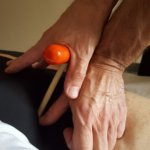
My non-dominant thumb, two thumbs barred together, a knuckle on my dominant hand, a knuckle on my non-dominant hand, a knuckle and thumb together, the other knuckle and thumb together, dominant elbow, non-dominant elbow, an L-bar (my favorite massage tool), a T-bar (my second favorite massage tool), an L-bar and my middle finger, an L-bar and my other middle finger, a T-bar and a thumb, T-bar and the other thumb, an L-bar and a knuckle…believe it or not, there are more.
Having as many pressing options allowed me to rotate body parts so that I wasn’t wearing one out.
In addition, squeezing by pressing between massage tools, hands and/or fingers is another great way to save your hands. Here’s a squeeze by pressing video: Trap Release Using a T-bar.
Heal Your Massage Injury and Eliminate Pain
The way to having a happy body starts with the question: How can I do a good massage without beating up my body?
By asking that question you establish the mindset to experiment with different strategies and techniques.
Once you find a move that bothers your body, you can than begin to find different ways to get the job done.
Here are some strategies and techniques that have worked for me:
Hand, Wrist and Forearm Pain
To eliminate hand, wrist and forearm pain think non-dominant fingers, thumb and elbow/forearm. Use combination tools, e.g, knuckle and thumb together. And instead of squeezing with one hand, try pressing between both hands.
Lower Back Pain
To knock out lower back pain: for medium to deep pressure, lean into the client and table. Having 2 or more points of contact on the client/table, make it easier on your back. For light pressure, bend your legs.
Neck, Shoulder and Arm Pain
To stop neck, shoulder, and arm pain: keep your work below, in front of and near you.
Once you start feeling better, you’ll never go back to the old way of doing massage. And if you do backslide, you won’t stay there for long.
 Need help with your massage injury or pain issue?
Need help with your massage injury or pain issue?
Take the massage-pain free quiz and get an instant recommendation on what you should do next.’
PAIN QUIZ


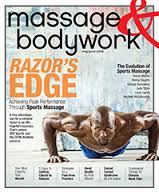
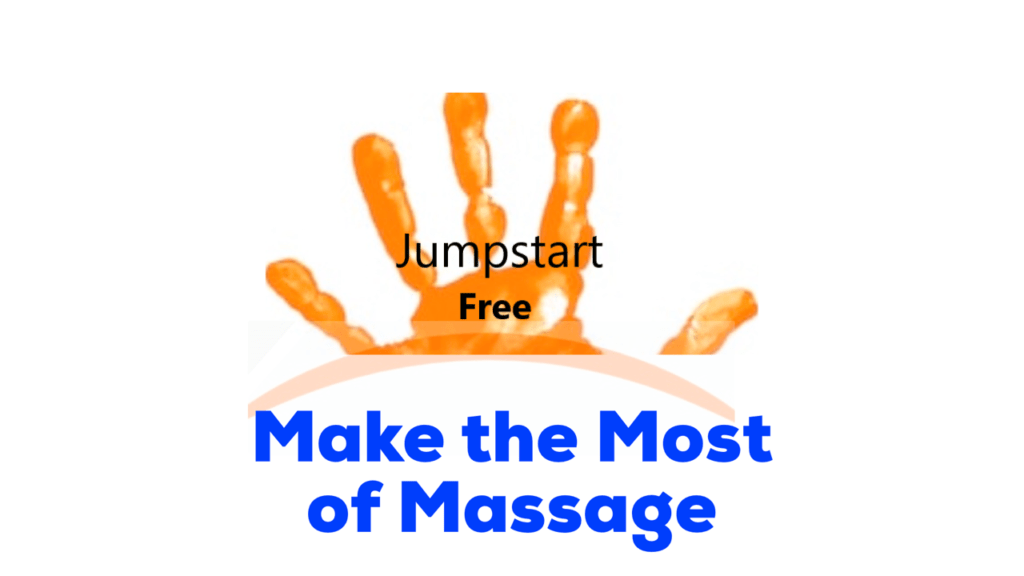
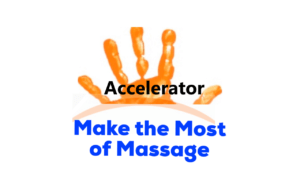
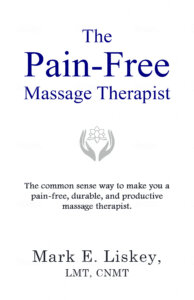
Comments on this entry are closed.
What are you doing with your feet? Turned directly into the table or at a slight turnout?
Hi Roslin, the position of my feet when leaning changes depending on the area I’m working. Sometimes my feet are perpendicular to the table to get the best leverage. Sometimes they are parallel to the table. In this video you get a better view of what my feet are doing when I’m leaning into different muscle areas: https://www.youtube.com/watch?v=s2GcDbM0R5I&index=22&list=UU5vq-0JwWZGv13b5x1VW64g&t=88s Hope that helps. Let me know. I have more videos that I can direct you to. Thanks!